历史
Founding
In July 1959, Essex County Council accepted a proposal from Alderman Charles (later Lord) Leatherland that a University be established in the county. A University Promotion Committee was formed chaired by Lord Lieutenant of Essex, Sir John Ruggles-Brise, which submitted a formal application to the University Grants Committee requesting that a University of Essex should be established. Initial reports suggested that the Promotion Committee had recommended Hylands Park in Chelmsford as the site for the new University, however in May 1961, the foundation of the University was announced in the House of Commons with Wivenhoe as the preferred location and in December of the same year, Wivenhoe Park was selected and acquired for the new university. In July 1962, Dr Albert Sloman, MA, DPhil, Gilmour Professor of Spanish and Dean of the Faculty of Arts, University of Liverpool, was appointed as Vice-Chancellor and the Rt. Hon. R A (later Lord) Butler, CH, MP, was invited to be Chancellor, with Mr A Rowland-Jones appointed as Registrar.
The first Professors were appointed in May 1963: Alan Gibson in Physics, Peter Townsend in Sociology, Donald Davie in Literature, Richard Lipsey in Economics, Ian Proudman in Mathematics, Jean Blondel in Government, and John Bradley in Chemistry. With its first staff appointed, a development plan for the university was published and a £1million Appeal Fund was launched, and within six months the Appeal Fund had exceeded its £1million target with The Queen Mother and Sir Winston Churchill among contributors, while work began on clearing the site for building work. In Autumn 1963, red was chosen as the University colour and the first prospectus was prepared and work began on the first permanent buildings; the science block and boiler room next to Wivenhoe House. In January 1964, Hardy Amies designed the university's academic robes and temporary teaching huts had to be erected close to Wivenhoe House, while in March Sir John Ruggles-Brise was appointed the first Pro-Chancellor and Alderman Leatherland the first Treasurer of the University. Two months later the university's Armorial Bearings were published, with the motto "Thought the harder, heart the keener".
The First Students
In October 1964, the first 122 students arrived with 28 teaching staff in three schools: Comparative Studies, Physical Sciences and Social Studies. Departments of Chemistry, Physics, Government, Sociology, Literature, Mathematics and Economics open along with the Language Centre (later the Department of Language and Linguistics) and the Computing Centre (later the Department of Computer Science) with Denis Mesure elected as the first President of the Students' Council. Work started on the first residential tower, Rayleigh in December with The Queen approving the grant of Charter to take effect from 11 January 1965.
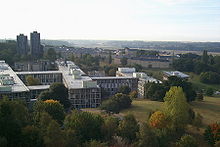
A view from one of the North Towers
1965 brought 399 students enrolling for the start of the new academic year; the number of academic staff more than doubled to 61; and the first degrees, five MSc and five MA degrees were awarded. The Physics building opened and the first six floors of Rayleigh tower were ready for occupation, while work began on the Albert Sloman Library. The first female lecturer was appointed: Dr Dorothy E. Smith in the Department of Sociology. In December, University Court met for the first time with around 500 members. Six months later, work started on the Lecture Theatre Building, plus the 'Topping out' of Keynes tower.
In October 1966, the Hexagon Restaurant and General Store opened, with the number of students reaching 750. Lord Butler was installed as Chancellor at a ceremony held in Colchester's Moot Hall in 1967 and the first Honorary Degrees were presented, the University's Mace was carried for the first time, while the first annual Degree Congregation saw 135 degrees conferred in July. At the start of the next academic year, the departments of Computer Science and Electronic Systems Engineering accepted their first students, the SSRC Data Bank (later renamed the UK Data Archive) was established and the Lecture Theatre Building and Library opened along with the first phase of the Social and Comparative Studies building, while work proceeded on Tawney and William Morris residential towers.
The 1960s
Essex University was at the forefront of 1960s student unrest. At a time of worldwide protest against the Vietnam War, the student movement was taking off all over the world. In March 1968, a demonstration against a visit to the University by Enoch Powell received national publicity. Seven students were summoned to a disciplinary hearings but student sit-ins prevented these hearings taking place.
On Tuesday, 7 May 1968, Dr Inch from Porton Down came to give a lecture at the university. In a carefully planned demonstration, an indictment was read out as Dr Inch attempted to speak, citing chemical and biological warfare activities at Porton Down. University authorities called in police with dogs, probably for the first time in an English university. Students outnumbered police and managed to prevent arrests.
On Friday, 10 May, three students, Pete Archard, Raphael Halberstadt and David Triesman (now Lord Triesman) were suspended and ordered off the campus. No evidence or charges were notified to the students, and no opportunity was given for the students to present their defence.
Wyvern reported that on Monday, 13 May, “Students picket all entrances to the University from early morning distributing leaflets calling all students and staff to meeting to discuss suspension of the three students. A huge meeting attended by nearly all the University population, voted overwhelmingly to refuse to participate in the University - in its place a Free University was declared ”.
The 1970s and the 1980s
Between the 1970s and the 1980s, the University added a Health Centre, printing centre, bookstore, exhibition gallery and expanded the current student residences. New student residences were also constructed during this time. The Wivenhoe House was later converted into a Conference Centre.
In the late 1970s, financial problems plagued the University and threatened its existence. During this later period of the 70s to the early 80s, the University began concentrating its teaching into large departments, allowing it to gain respect nationally and internationally in academics and teaching. Cooperation with local companies was forged, allowing the university to secure vital research contracts. Due to its growing international reputation, the University began to attract a sizable number of International Students.
The 1990s
The University entered the 1990s with the expansion of its facilities, adding new residential blocks to provide further living space for its student population between 1991 and 1992. The Rab Butler building was opened in 1991 as the headquarters for the British Household Panel Survey. By its 30th Anniversary in 1993, the University had built itself up into 17 key departments, providing education and research opportunities for 5,500 students, and employing 1,300 staff and faculty. The University also contained 5 industrial units and housed the Economic and Social Research Council's Data Archive. Further expansion continued to take place after 1993, with the £5.5 million expansion scheme for the provision of 234 new apartments for 1,200 students in a new student village.
Recent Developments
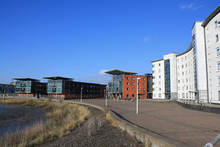
University Quays (student residence)
On 25 November 2004, Her Majesty the Queen and the Duke of Edinburgh visited the University as part of its 40th anniversary celebrations (1964–2004). The University's first student, John M. Dowden, who started postgraduate research on fluid dynamics at the age of 23 in 1963, became a professor of mathematics and was the head of the University's Mathematics Department from 2001-2005. He retired in September 2008.
The University is constantly expanding. The Network Centre building opened in May 2004 housing the Department of Electronic Systems Engineering and parts of the Department of Computer Science (who merged in 2007 to create Computer and Electronic Systems). The University Quays, a student accommodation complex housing 770 students, opened in September 2003. The Ivor Crewe lecture Theatre, with a 1,000 seat capacity, opened in 2006. In Southend the £26m Gateway Building opened in 2007, a former church been converted to the Clifftown Town Centre providing East 15 students with studios and workshop spaces. A new 560 bedroom development is currently under construction near to the Gateway building and is expected to open in September 2010. At Wivenhoe Park, the 'Social Science Research Centre' was completed in February 2007, housing the University's Institute of Social and Economic Research and the UK Data Archive. A new building for the School of Health and Human Sciences was opened in 2008, as was the 'Centre for Brain Science' housing part of the Psychology department. Work is due to start on a multi-phase 'Knowledge Gateway' project on the Wivenhoe campus during 2010.
A panorama of the University of Essex. Foreground: Boundary Road. Background: [L-R] North Accommodation Towers, Networks Centre, Podium, Psychology Building, Psychology Building Extension, South Accommodation Towers, South Courts.
Departments and Research Centres
The University is organised into four faculties, comprising 18 schools and departments, spanning the Humanities, Law and Management, Social Sciences and Science and Engineering. Its departments of Economics, Government (Political Science), Sociology and Language and Linguistics are particularly well-known and are among the best in Europe. Essex's research in politics, economics and sociology received top (5*) ratings in the UK government's 2001 Research Assessment Exercise.
The Institute for Social and Economic Research (ISER) is a leading research centre for the analysis of panel data in Economics and Sociology. It opened in 1989 as the ESRC Research Centre on Micro-Social Change in Britain.
Broadening the University's Social Scientific approach is Chimera - the Institute for Social and Technical Research that specialises in analysing the relationship between technology and society. With strong industrial links to British Telecom, Kodak and Sun Microsystems and responding to the themes of ubiquitous computing and ambient intelligence is the institute's Digital Lifestyles Centre and its research facility the iSpace, which provides a flexible testbed for future digital-home technology. Also within Chimera is the Technology and Social Change Centre (TaSC). With research funded by the ESRC, the European Commission, UK Government Departments and industrial partners such as Intel, TaSC applies advanced quantitative and qualitative methods including spatial microsimulation, regression analysis and focus group work, to understand how technology interacts with a range of social, political and economic outcomes.
The Centre for Computational Finance and Economic Agents (CCFEA) studies evolutionary methods to simulate markets with artificially intelligent agents.
In September 2000 the East 15 Acting School became part of the University. The School is based in Loughton in southwest Essex and has a branch in Southend.
Partner Institutions
The University has strong regional agenda and a number of partner institutions in the region: Colchester Institute, South Essex College (in Southend), Writtle College (near Chelmsford), the Tavistock and Portman Trust (in London) and Insearch, University Campus Suffolk, a joint venture with the University of East Anglia, with a central campus in Ipswich and five centres in Suffolk and Norfolk. Its latest partner is Kaplan Open Learning, delivering on-line foundation degrees. The University's partners offer complementary provision to that offered by the University, typically with a stronger focus on undergraduate, vocational programmes.
Reputation
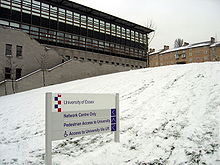
The Psychology building in winter
Essex is among the smallest multi-faculty universities in Britain and is a member of the 1994 Group. Despite its small size, Essex has developed an international reputation for teaching and research. The annual Summer School in Social Science Data Analysis and Collection, now approaching its 41st year, attracts faculty and students from all over the world as does the world renowned human rights centre celebrating its 25th year.
The university was known as a left-wing hotbed with respect to faculty and students, but today is characterized, as most UK campuses, by rather less radical student politics.
The University uniquely in the UK achieved top 5* rankings in the 2001 Research Assessment Exercise (RAE) for the three core social science disciplines - economics, government and sociology - with government and sociology upgraded to the new 6* grade.
Rankings
According to an annual Times Higher-QS world ranking exercise, the University is ranked amongst the world's top-300 universities, placed at 258. The University also performs relatively well in the Guardian, Times & The Independent Rankings for Universities. It recently placed 31st in the Guardian's 2009 League Table, 34th in the Times 2009 Good University Guides, and 25th in The Independent's University Guide 2009. A separate Subject Ranking of Political Science Departments by Simon Hix of the London School of Economics places the University's Government Department 17th worldwide, ahead of the University of Cambridge & University of Oxford in the UK but behind the London School of Economics.
The University confirmed its position as one of the UK’s elite research universities when it was ranked as the 9th-best university in the UK for the quality of its research in The Times, The Guardian and The Independent the 2008 Research Assessment Exercise (RAE).
UK University Rankings
|
2009 |
2008 |
2007 |
2006 |
2005 |
2004 |
2003 |
2002 |
2001 |
2000 |
1999 |
1998 |
1997 |
1996 |
1995 |
1994 |
1993 |
| Times Good University Guide |
42 |
36 |
30 |
29 |
27 |
30 |
25 |
31 |
29 |
29 |
29 |
24 |
20 |
29 |
36= |
32= |
46= |
| Guardian University Guide |
36 |
43 |
31 |
31 |
47 |
48 |
17 |
10 |
|
|
|
|
|
|
|
|
|
| Sunday Times University Guide |
|
39 |
40 |
36 |
33 |
33 |
32 |
36 |
30 |
28 |
30= |
30 |
|
|
|
|
|
| Daily Telegraph |
|
|
34 |
|
|
|
23 |
|
|
|
|
|
|
|
|
|
|
| Independent - Complete University Guide |
25 |
34 |
|
|
|
|
|
|
|
|
|
|
|
|
|
|
|
| FT |
|
|
|
|
|
|
29 |
|
17 |
25 |
25 |
|
|
|
|
|
|
Wivenhoe Park campus
The main campus, Wivenhoe Park, was once painted by famous landscape painter John Constable. With its concrete architecture, it is typical of England's 60s' universities and quite similar to that of the University of East Anglia. Wivenhoe Park houses the main 1960s buildings along with an 18th century house that also features in Constable's painting. Wivenhoe House is now operated as a hotel and conference centre, forming one of the facilities marketed under the Venue Essex banner.
There are 2 small lakes on campus (in the middle of one is the Vice-Chancellor's House).
The architect of the University of Essex campus took the Tuscan town of San Gimignano with its squares and towers as an inspiration (the University has six residential towers mainly for undergraduates, but the original plan was to build 29). As well as the towers, South Courts and the University Quays residences provide enough space to guarantee every first year a place on campus as well as all overseas students. Due to its particular form of architecture involving the use of prefabricated concrete and glass, the University is referred to as a Plate Glass University.
The library has one of the few remaining still operating continuous loop paternoster lifts in the country.
Student Body
The University has a very large population of international students, with between 30% and 40% being international overall. Nearly 50% of postgraduates, and a quarter of undergraduates are students whose country of origin is outside of the UK. The University boasts a large proportion of local students from state schools, and a third of its undergraduates are from working class homes.
Students' Union
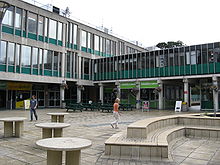
Students' Union across Square 3
The University of Essex Students' Union is well regarded nationally. It has a very successful volunteering programme that is a national award winner. It has been successful in expanding services offered including considerable expansion and relocation of its Advice Centre. The Students' Union runs the majority of commercial services on campus. Its shops stock a great deal of imported food products, reflecting the University's international community. It has many licensed venues, the primary venues being the Student Union Bar and the Top Bar. There are club-style venues: Mondo, Level 2, and the newly refurbished Sub Zero (formerly the Underground), which have hosted many bands and top name DJ's, including R.E.M., AC/DC, The Kinks, DJ Nibby, Pink Floyd & The Pretenders supported by the then little known UB40, Iggy Pop and the Sugababes, whilst in recent times Maxïmo Park, Editors, The Paddingtons, The Subways, Babyshambles, Boy Kill Boy and The Young Knives, Pendulum, Calvin Harris, DJ Luck and MC Neat, Trevor Nelson, Florence and the Machine, DJ Paul Oakenfold and Sash! continue its reputation. Sub Zero was voted best student union venue upon its refurbishment and is one of the biggest in the country, with a capacity of over 1,200. Plans have been made to refurbish the SU bar and Top Bar in the summer 2010.
The Students Union employs about 380 students to work in its shops and venues. The university of Essex Students Union was the first SU in the UK to receive the 'Investors in people Gold' award in late 2009.
The Students' Union underwent a wide scale reform in 2007-8, in which the trustee and executive functions were separated, and greater voice was given to satellite campuses. The Executive Committee on the main Colchester campus is composed of 5 full time officers (the President and 4 vice-presidents) and 7 part-time officers. The Students' Union is a member of the National Union of Students and many of its members are actively involved.
Mark Bergfeld, the current Campaigns Officer, former International Students' Officer (2007–2008) and Participation and Involvement Officer (2008–2009), ran for NUS Vice-President Higher Education and Block of 15 at the National Union of Students National Conference in Newcastle. After receiving the second highest amount of first preferences Mark Bergfeld now sits on the NUS National Executive Council (NEC).
Student Media
The student newspaper is The|Rabbit, named after the many rabbits which can be seen on campus. It had been suggested that the editing of The|Rabbit had previously been somewhat prejudiced due to its affiliation with the Students' Union Executive Committee. As of the academic year 2006-2007, it is now loosely autonomous from the Students' Union.
The student radio station is called RED Radio previously RED - 1404 AM broadcasts on 1404AM and over the Internet, and was the second student radio station in the UK. 建立于 in 1971 it was originally called URE (University Radio Essex). During 2008/2009 year the station underwent a partial rebrand create a better identity in order to increase its development and participation from university members. There is also a student-run TV production company called SX:TV, who won the award for best IDENT at the National Student Television Awards 2009.
Television
|
|
The neutrality of this article is disputed. Please see the discussion on the talk page. Please do not remove this message until the dispute is resolved. (September 2009) |
The university has had a media channel since 2003. It began as UTV meaning to be 'your' tv but the station petered out due to inactivity. Then a relaunch was attempted in the academic year 2005-06 where the station was called R:TV meaning Red/Rabbit television. The station established itself as an official structure but it lacked acquaintance with its viewers. The final and successful relaunch of the station occurred in the academic year 2008-09 when the station was branded as it is today as SX:TV. SX:TV comes from the shortening of Essex, the University where the station is based. The station as an organisation has moved on from the shaky starts to strong strides.
SX:TV made its debut at the 2009 NaSTA awards. The station was nominated for awards in five categories and won an award for best ident.
The SX:TV tiger is one of many projects undertaken by SX:TV. Other projects include news features, live shows, music videos, filming acts from DJ sets to bands to comedy nights. SX:TV also aims to capture major events happening on campus such as the student union elections and the summer ball. SX:TV is currently involved in producing programmes for next year as well as developing an independent website.
The position of station manager is an annual term. Each year a new station manager is recruited and trained to fulfill the job role. SX:TV itself consists of a dedicated and experienced team that comes up with the ideas and scripts and furthermore the team independently directs, produces and edits its own material.
The Essex Human Rights Review
The Essex Human Rights Review is a student-run open-access academic journal that publishes human rights related works from a variety of disciplinary perspectives. It publishes issues seasonally and runs one thematic special issue publication per year.
Sports
The University has a wide range of sports clubs, including many unusual sports such as disc golf and American Football. Many of the University's Sports Clubs, known as the Essex Blades, achieve national success. In 2005-06, the Pool Team became the best in Britain winning the BUSA Championships defeating Cardiff in the final. In the 2007-08 season the University of Essex Rugby Club won the BUSA Vase defeating Robert Gordon University 15-10 in the final as well as achieving promotion. The University's Basketball and Netball clubs also reached BUSA finals in the 2007-08 season. The University boasts a well-equipped sports centre, including a fitness suite, squash courts, netball and tennis courts and a 9 m climbing wall used by the University of Essex Mountaineering Club. The University has its own sailing clubhouse and boat-park at nearby Brightlingsea. The gym surface was doubled in 2010 to allow more students to fit in and improve the quality and environment of the training facilities.
Once a year, a special event called 'Derby Day' sees a wide sport contest between the University of Essex clubs and the University of East Anglia sport teams. The event is hosted alternatively by Essex and UEA. Essex hosted the 2010 edition that saw the Blades win 30 to 15.
Recent Buildings
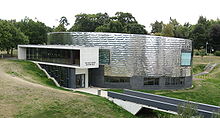
The Ivor Crewe Lecture Hall
The Ivor Crewe Lecture Hall, which opened in October 2006 and was designed by the architect Patel Taylor, has attracted a mixed response, with Prince Charles reputedly referring to it as 'like a dustbin'., while the Civic Trust, a charity of which he is patron, have awarded it a Civic Trust award (2008) for making 'an outstanding contribution to the quality and appearance of the environment', some students affectionately call the building 'the tuna can'. The building was named after Professor Sir Ivor Crewe in April 2007, to mark his retirement from the position of vice chancellor, a position he had held since 1995.
The University's new £30m 'Gateway' building in Southend was opened in January 2007, housing the academic activities including business, health and acting, as well as being home to programmes operated in collaboration with Queen Mary Dental School, a GP practice and a business incubation centre.
New buildings have recently opened housing the departments of Psychology and Health and Human Sciences.
In February 2009, after being announced as a top 10 university for research, the university unveiled plans for several new additions to campus including a student centre to be constructed as an extension to the library, and an entirely new sector of accommodation (currently planned to be erected in the meadows between campus and the university quays) along with refurbishments of the current campus. These plans are a result of governmental and industry grants of around £250m.
Links with industry
Through the 1990s, and the influence of policy activity in the United States stimulated by the Bayh-Dole Act, the British Government has sought to strengthen the links between universities and industry as a means to contribute to economic growth and the technological capacity of companies through technology transfer and exploitation of university ideas. Essex University has received grants from the Higher Education Innovation Fund (HEIF) delivered by HEFCE and other government departments to develop such capacity to link with industry. A Research and Enterprise Office has been established, which is to be complemented with the development of a research park adjacent to the campus.. Links between the university and industry have mostly been found within the School of Computer Science and Electronic Engineering (CSEE). CSEE has maintained a long standing relationship with the Japanese photography and printing company, Canon, as well as links with British Telecom.
Notable alumni
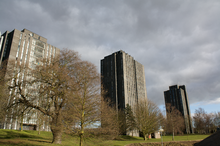
North Towers (student residences)
In its relatively short history, the University of Essex has produced many notable graduates in the field of Politics, Social Science, Technology and the Arts, as well as a Nobel Prize Winner.
The Current President of Costa Rica, Óscar Arias, completed his doctorate in Political Science at the University in 1973, and received the Nobel Peace Prize in 1987. Ex-Vice President of Costa Rica, Dr Kevin Roberto Casas Zamora, also completed his studies in Essex, earning a MA in Latin American Government & Politics in 1993. Other political figures educated at Essex include the foreign ministers of Slovenia (Dimitrij Rupel) & Iraq (Hoshyar Zebari), Conservative Party MPs Virginia Bottomley & John Bercow, now Speaker of the House of Commons, Labour Party MP Siobhain McDonagh, Pakistani Social Activist Omar Asghar Khan, South African politician Thozamile Botha and Singapore Workers' Party politician James Gomez (MA 1994). Two of those convicted of conspiracy to cause explosions connected to The Angry Brigade, Hilary Creek and Anna Mendleson, had been to Essex University but left without taking their degrees.
Notable alumni in the field of the Humanities & Media include Stephen Daldry & Mike Leigh, who both studied at the East 15 Acting School (part of the University of Essex since 2001), the Artistic Director William Burdett-Coutts (MA Drama), the Documentary Filmmaker Nick Broomfield, the TV comedy producer Geoff Posner, the Malaysian Poet Kee Thuan Chye, the veteran BBC Correspondent Brian Hanrahan, the novelists Lucy Ellman, Jonathan Wilson, Tim Binding, John Lawton, as well as the Booker Prize-winning author Ben Okri, and the jazz guitarist John Etheridge.
In the field of architecture, world-renowned architect Daniel Libeskind, who was recently commissioned to rebuild the World Trade Center Site in New York City, attended Essex and completed an MA in the History and Theory of Architecture in 1972. The architectural historian Alberto Pérez-Gómez, subsequently head of the History and Theory of Architecture program at McGill University in Canada, obtained his M.A. and Ph.D. degrees at Essex, graduating in 1975.
Many of the University's graduates have gone on to staff various university departments worldwide. Notable examples include the late Professor Erkin Bairam (Economics, Otago), Dr. Farish A. Noor (NTU), Professor Michael Taylor (Politics, Washington) and Professor Jean Drèze (Economics, Delhi). It has been estimated that half of the sociology professors in UK Higher Education have completed all or part of their education at Essex.. Some graduates have returned to Essex to hold positions within the University's various academic departments. These include the philosopher Simon Critchley, Dean of International Development, Martin Henson and the Director of Essex's Human Right's Centre, John Packer.
In 2009 it was reported that Essex University graduates go on to greater than average success in business when compared with other universities..
- See: List of University of Essex people
External links
 |
Wikimedia Commons has media related to: University of Essex |
- University of Essex website
- University of Essex Students' Union
- Informal guide to being a student at the University of Essex
- Institute for Social and Economic Research website
- May 1968 events
参考文献
- ^ "Essex appoints new Vice-Chancellor". University of Essex. 2007-03-06. http://www.essex.ac.uk/news/2007/nr20070306.htm. Retrieved 2007-09-12.
- ^ "University of Essex Profile". http://universitiesprofile.com/uk_Essex.htm. Retrieved 2008-07-09.
- ^ "Essex University - British History Online". http://www.british-history.ac.uk/report.aspx?compid=22014#n4. Retrieved 2008-08-01.
- ^ "University of Essex: Raising expectations on the east coast". The Independent (London). 2008-03-13. http://www.independent.co.uk/news/education/higher/university-of-essex-raising-expectations-on-the-east-coast-794752.html. Retrieved 2008-08-02.
- ^ "2001 Research Assessment Exercise - Institution: H-0118 University of Essex" (PDF). Higher Education and Research Opportunities (HERO). 2001. http://195.194.167.103/Results/byinst/H-0118.pdf. Retrieved 2007-08-07.
- ^ http://www.essex.ac.uk/chimera/
- ^ http://www.essex.ac.uk/ccfea/
- ^ http://www.colchester.ac.uk/
- ^ http://www.southend.ac.uk/
- ^ http://www.writtle.ac.uk/Writtle College
- ^ http://www.tavi-port.org/
- ^ http://www.insearch.essex.ac.uk/
- ^ http://kaplanopenlearning.org.uk/
- ^ http://www.essex.ac.uk/methods/
- ^ http://www2.essex.ac.uk/human_rights_centre/
- ^ "HERO - Higher Education & Research Opportunities in the UK: the Research Assessment Exercise (RAE) 2001". 2008-04-24. http://www.hero.ac.uk/rae/.
- ^ "QS Top Universities: Top 400 Universities in the World". 2008-04-24. http://www.topuniversities.com/worlduniversityrankings/results/2007/overall_rankings/top_400_universities/.
- ^ "Guardian Unlimited University Guide 2009 - University Rankings". The Guardian (London). http://browse.guardian.co.uk/education?SearchBySubject=&FirstRow=&SortOrderDirection=&SortOrderColumn=&Subject=University+ranking&Institution=Essex. Retrieved 2008-08-02.
- ^ "The Times Good University Guide 2009". London. http://extras.timesonline.co.uk/tol_gug/gooduniversityguide.php. Retrieved 2008-08-02.
- ^ "The Independent - The main league table 2009". London. 2008-04-24. http://www.independent.co.uk/news/education/higher/the-main-league-table-2009-813839.html. Retrieved 2008-08-02.
- ^ [http://personal.lse.ac.uk/hix/Working_Papers/Hix-PolStudiesReview-2004.pdf "A Global Ranking of Political Science Departments - Simon Hix"] (Adobe PDF document). Simon Hix, LSE. http://personal.lse.ac.uk/hix/Working_Papers/Hix-PolStudiesReview-2004.pdf. Retrieved 2008-08-02.
- ^ "The Guardian - Rankings for UK universities in the Research Assessment Exercise 2008". London. 2008-12-18. http://www.guardian.co.uk/education/table/2008/dec/18/rae-2008-results-uk-universities. Retrieved 2009-08-29.
- ^ "The Times - Rankings for UK universities in the Research Assessment Exercise 2008". http://www.timeshighereducation.co.uk/Journals/THE/THE/18_December_2008/attachments/RAE_2008_THE_RESULTS.pdf. Retrieved 2009-08-29.
- ^ The Times (London). http://extras.timesonline.co.uk/tol_gug/gooduniversityguide.php. Retrieved 2010-04-09.
- ^ "The Times Good University Guide 2008". The Times (London). http://extras.timesonline.co.uk/gug/gooduniversityguide.php. Retrieved 2007-11-03.
- ^ "The Times Good University Guide 2007 - Top Universities 2007 League Table". The Times (London). http://www.timesonline.co.uk/displayPopup/0,,102571,00.html. Retrieved 2007-11-03.
- ^ "The Times Top Universities". The Times (London). http://www.timesonline.co.uk/displayPopup/0,,32607,00.html. Retrieved 2007-11-03.
- ^ "University ranking by institution". The Guardian (London). http://browse.guardian.co.uk/education?SearchBySubject=&FirstRow=29&SortOrderDirection=&SortOrderColumn=GuardianTeachingScore&Subject=University+ranking&Institution=. Retrieved 2007-10-29.
- ^ "University ranking by institution". The Guardian (London). http://browse.guardian.co.uk/education/2006?SearchBySubject=&FirstRow=20&SortOrderDirection=&SortOrderColumn=GuardianTeachingScore&Subject=Institution-wide&Institution=. Retrieved 2007-10-29.
- ^ "University ranking by institution". The Guardian (London). http://education.guardian.co.uk/universityguide2005/table/0,,-5163901,00.html?start=40&index=3&index=3. Retrieved 2007-10-29.
- ^ "University ranking by institution 2004". The Guardian (London). http://education.guardian.co.uk/universityguide2004/table/0,,1222167,00.html. Retrieved 2009-01-19.
- ^ "University ranking by institution". The Guardian 2003 (University Guide 2004) (London). http://education.guardian.co.uk/higher/unitable/0,,-4668575,00.html. Retrieved 2010-04-09.
- ^ "The 2002 ranking - From Warwick". Warwick Uni 2002. http://www2.warwick.ac.uk/services/academicoffice/ourservices/planning/businessinformation/academicstatistics/2002/table_81.xls.
- ^ "The Sunday Times Good University Guide League Tables". The Sunday Times (London). http://extras.timesonline.co.uk/stug/universityguide.php. Retrieved 2007-11-03.
- ^ "The Sunday Times University League Table" (PDF). The Sunday Times (London). http://extras.timesonline.co.uk/stug2006/stug2006.pdf. Retrieved 2007-11-03.
- ^ "University ranking based on performance over 10 years" (PDF). London: Times Online. 2007. http://extras.timesonline.co.uk/pdfs/univ07ten.pdf. Retrieved 2008-04-28.
- ^ "University league table". The Daily Telegraph. London. http://www.telegraph.co.uk/news/main.jhtml;jsessionid=HXFCSGXMNVABTQFIQMFCFGGAVCBQYIV0?xml=/news/2007/07/30/ncambs430.xml. Retrieved 2007-10-29.
- ^ "The Independent University League Table". The Independent (London). 2008-04-24. http://www.independent.co.uk/news/education/higher/the-main-league-table-2009-813839.html. Retrieved 2010-04-09.
- ^ "The FT 2003 University ranking". Financial Times 2003. http://www.grb.uk.com/448.0.html?cHash=5015838e9d&tx_ttnews%5Btt_news%5D=9&tx_ttnews%5Buid%5D=9.
- ^ "FT league table 2001". FT league tables 2001. http://specials.ft.com/universities2001/FT3HLLAN6LC.html.
- ^ "FT league table 1999-2000". FT league tables 1999-2000. http://specials.ft.com/ln/ftsurveys/industry/pdf/top100table.pdf.
- ^ "FT league table 2000". FT league tables 2000. http://specials.ft.com/ln/ftsurveys/industry/scbbbe.htm.
- ^ http://www.wivenhoehousehotel.co.uk/
- ^ http://www.essex.ac.uk/venue-essex/
- ^ "University of Essex Profile: The Times". London. 2009-05-31. http://www.timesonline.co.uk/tol/life_and_style/education/good_university_guide/article2166448.ece. Retrieved 2008-08-01.
- ^ http://www.nasta.tv/awards/promo.html
- ^ http://www.sxtvonline.com
- ^ "BBC News - Prince calls £6m hall 'a dustbin'". 2008-02-16. http://news.bbc.co.uk/2/hi/uk_news/england/essex/7248749.stm. Retrieved 2008-08-04.
- ^ "'Dustbin' lecture hall wins award". BBC News. 2008-03-13. http://news.bbc.co.uk/2/hi/uk_news/england/essex/7293569.stm. Retrieved 2008-08-02.
- ^ "University honours Vice-Chancellor". University of Essex Communications Office. 2007-04-03. http://www.essex.ac.uk/news/2007/nr20070403.htm. Retrieved 2008-02-29.
- ^ "£50m research park plan unveiled - BBC News". 2005-12-08. http://news.bbc.co.uk/1/hi/england/essex/4510976.stm. Retrieved 2008-08-01.
- ^ "University of Essex Profile - The Independent". London. 2009-06-16. http://www.independent.co.uk/student/into-university/az-uni-colleges/essex-university-of-458925.html. Retrieved 2008-08-02.
- ^ "Essex Students Go On To Greater Success - Essex Portal". http://www.essexportal.co.uk/news/essex-news/essex-students-go-on-to-greater-success. Retrieved 2009-08-29.
|
|
This article needs additional citations for verification.
Please help improve this article by adding reliable references. Unsourced material may be challenged and removed. (August 2007) |



